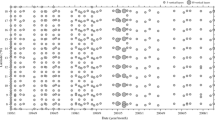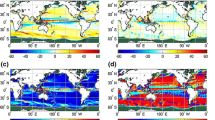Summary
Approximately twice-monthly expendable bathythermograph (XBT) sections between Europe and Brazil, are used to characterize trends in the equatorial geostrophic surface currents orthogonal to the sections between September, 1980 and May, 1984. Using mean temperature-salinity relationships the upper layer temperature profiles are converted to density and used to compute 0/300 db dynamic height. Applying a second derivative method, at and near the equator, geostrophic surface currents are computed along each quasimeridional XBT section and time/space series of the equatorial currents are developed using spline interpolations in both time and space. Equatorial currents are mapped as time series of dynamic height and geostrophic current.
Zusammenfassung
Es werden zweimonatliche Bathythermographenschnitte zwischen Europa und Brasilien vom September 1980 bis Mai 1984 vorgestellt. Die Daten werden zur Darstellung eines mehrjährigen Trends im oberflächennahen äquatorialen Stromsystem verwandt, welches senkrecht zu den Schnitten liegt. Unter Ausnutzung einer mittleren Temperatur-Salzgehaltsbeziehung werden die Temperaturprofile in Dichteprofile überführt. Aus diesen wird die dynamische Tiefe (0/300 dbar) errechnet. In Äquatornähe wird eine rechnerische Näherung für die geostrophischen Ströme verwandt. Ferner wird ein Spline-Interpolationsverfahren für die raumzeitliche Herleitung der quasi-meridionalen Strömungsverteilung genutzt. Das äquatoriale Stromsystem wird als eine Zeitserie der dynamischen Tiefe und der geostrophischen Ströme dargestellt.
Résumé
Des coupes thermiques au moyen de Bathythermographes à tête perdue (XBT) entre l'Europe et le Brésil environ deux fois par mois de septembre 1980 à mai 1984 sont utilisées pour caracteriser des tendances dans les courants géostrophiques équatoriaux perpendiculaires à ces coupes. Les profils de température dans les couches superficielles sont convertis en profils de densité au moyen de relations temperature-salinité moyennes, et permettent de calculer la hauteur dynamique 0/300 db. Après interpolation (spline) dans le temps et l'espace, on obtient une série spatio-temporelle, présentée sous la forme de cartes trimestrielles de hauteurs dynamiques et de courants géostrophiques.
Similar content being viewed by others
References
Arnault, S., 1984: Variation saisonniere de la topographis dynamique et de la circulation superficielle de l'Ocean Atlantique Tropical. Thesis 3ieme Cycle, Univ. of Paris IV.
Busalachi, A. J. and J. Picaut, 1983: Seasonal variability from a model of the Tropical Atlantic Ocean. J. Phys. Oceanogr.13, 1564–1588.
Delcroix, Th., 1986: The North Equatorial Countercurrent inferred from dynamic height and thermocline depth. Tropical Ocean-Atmosphere News.34, 5–6.
Emery, W. J. and J. S. Dewar, 1982: Mean temperature-salinity, salinity-depth and temperature-depth curves in the North Atlantic and North Pacific. Prof. Oceanogr.11, 219–305.
Garzoli, S. L. and E. J. Katz, 1983: The forced annual reversal of the Atlantic North Equatorial Countercurrent. J. Phys. Oceanogr.3, 2082–2090.
Käse, R. H., J. F. Price, P. L. Richardson and W. Zenk, 1986: A quasisynoptic survey of the thermocline circulation and water mass distribution within the Canary Basin. J. Geophys. Res.91, 9739–9748.
Katz, E. J., 1981: Dynamic topography of the sea surface in the equatorial Atlantic. J. Mar. Res.39, 53–63.
Lukas, R. and E. Firing, 1984: The geostrophic balance in the Pacific Equatorial Undercurrent. Deep-Sea Res.31, 61–66.
Merle, J. and S. Arnault, 1985: Seasonal variability of the surface dynamic topography in the tropical Atlantic Ocean. J. Mar. Res.43, 267–288.
Richardson, P. L. and R. G. McKee, 1984: Average seasonal variation of the Atlantic equatorial currents from historical ship drift. J. Phys. Oceanogr.14, 1226–1238.
Richardson, P. L. and D. Walsh, 1986: Mapping climatological seasonal variations of surface currents in the tropical Atlantic using ship drift. J. Geophys. Res.91, 10537–10550.
Rual, P. and R. Jarrige, 1984: Tropical Atlantic thermal structure along the Europe-Brazil ship line. Geophys. Res. Let.11, 775–778.
Tsuchiya, M., 1955a: On a simple method of estimating the current velocity at the equator. J. Oceanogr. Soc. Japan.11, 1–4.
Tsuchiya, M., 1955b: On a simple method for estimating the current velocity at the equator. Res. Oceanogr. Works Japan.2, 347–42.
Author information
Authors and Affiliations
Rights and permissions
About this article
Cite this article
Emery, W.J., Zenk, W., Huber, K. et al. Trends in Atlantic equatorial current variability. Deutsche Hydrographische Zeitschrift 40, 261–276 (1987). https://doi.org/10.1007/BF02226280
Received:
Accepted:
Published:
Issue Date:
DOI: https://doi.org/10.1007/BF02226280




